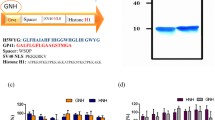Abstract
Peptides have an interesting potential as gene transfer agents not only because they are biodegradable but also due to their reduced size and the facility of product characterization and large-scale production. Recently, we have shown that the cationic amphipathic 26-mer peptide LAH4 possesses high DNA delivery capacities. To better understand its way of functioning and to further improve its efficiency, we synthesized and tested various LAH4 derivatives. The evaluation of their DNA delivery capacity, as well as their transfection efficiency, makes accessible valuable information about structure–function correlations. In particular, our results indicate the threshold peptide concentration for endosomal escape and conformational preferences for the peptide. Furthermore, the results indicate that a fine balance of peptide–DNA interactions is responsible for the high transfection activity of LAH4. Taken together, the data also suggest that the peptides efficiently transport DNA into the cytoplasm and that the creation of more potent transfection compounds probably needs improvement of other steps during the process.





Similar content being viewed by others
Abbreviations
- CMV:
-
cytomegalovirus
- EtBr:
-
ethidium bromide
- Luc:
-
luciferase
- PEI:
-
polyethylenimine
- pLys:
-
poly-l-lysine
References
Ilies MA, Balaban AT (2001) Recent developments in cationic lipid-mediated gene delivery and gene therapy. Expert Opin Ther Pat 11:1729–1752
Martin B, Sainlos M, Aissaoui A, Oudrhiri N, Hauchecorne M, Vigneron JP, Lehn JM, Lehn P (2005) The design of cationic lipids for gene delivery. Curr Pharm Des 11:375–394
Kichler A, Leborgne C, Marz J, Danos O, Bechinger B (2003) Histidine-rich amphipathic peptide antibiotics promote efficient delivery of DNA into mammalian cells. Proc Natl Acad Sci U S A 100:1564–1568
Bechinger B (2005) Detergent-like properties of magainin antibiotic peptides: a 31P solid-state NMR spectroscopy study. Biochim Biophys Acta 1712:101–108
Bechinger B (1996) Towards membrane protein design: pH-sensitive topology of histidine-containing polypeptides. J Mol Biol 263:768–775
Hirt B (1967) Selective extraction of polyoma DNA from infected mouse cell cultures. J Mol Biol 26:365–369
Goula D, Remy JS, Erbacher P, Wasowicz M, Levi G, Abdallah B, Demeneix BA (1998) Size, diffusibility and transfection performance of linear PEI/DNA complexes in the mouse central nervous system. Gene Ther 5:712–717
Wightman L, Kircheis R, Rossler V, Carotta S, Ruzicka R, Kursa M, Wagner E (2001) Different behavior of branched and linear polyethylenimine for gene delivery in vitro and in vivo. J Gene Med 3:362–372
Vogt TC, Bechinger B (1999) The interactions of histidine-containing amphipathic helical peptide antibiotics with lipid bilayers. The effects of charges and pH. J Biol Chem 274:29115–29121
Mason AJ, Martinez A, Glaubitz C, Danos O, Kichler A, Bechinger B (2006) The antibiotic and DNA transfecting peptide LAH4 selectively associates with, and disorders, anionic lipids in mixed membranes. FASEB J 20:320–322
Bechinger B (1997) Structure and functions of channel-forming peptides: magainins, cecropins, melittin and alamethicin. J Membr Biol 156:197–211
Pichon C, Guerin B, Refregiers M, Goncalves C, Vigny P, Midoux P (2002) Zinc improves gene transfer mediated by DNA/cationic polymer complexes. J Gene Med 4:548–559
Erbacher P, Roche AC, Monsigny M, Midoux P (1996) Putative role of chloroquine in gene transfer into a human hepatoma cell line by DNA/lactosylated polylysine complexes. Exp Cell Res 225:186–194
Cotten M, Langle-Rouault F, Kirlappos H, Wagner E, Mechtler K, Zenke M, Beug H, Birnstiel ML (1990) Transferrin-polycation-mediated introduction of DNA into human leukemic cells: stimulation by agents that affect the survival of transfected DNA or modulate transferrin receptor levels. Proc Natl Acad Sci U S A 87:4033–4037
Kichler A, Bechinger B, Danos O (2003) Antimicrobial peptides as efficient DNA vectors. Med Sci 19:1046–1047
Wyman TB, Nicol F, Zelphati O, Scaria PV, Plank C, Szoka FC (1997) Design, synthesis, and characterization of a cationic peptide that binds to nucleic acids and permeabilizes bilayers. Biochemistry 36:3008–3017
Kichler A, Pages JC, Leborgne C, Druillennec S, Lenoir C, Coulaud D, Delain E, Le Cam E, Roques BP, Danos O (2000) Efficient DNA transfection mediated by the C-terminal domain of human immunodeficiency virus type 1 viral protein R. J Virol 74:5424–5431
Coeytaux E, Coulaud D, Le Cam E, Danos O, Kichler A (2003) The cationic amphipathic alpha-helix of HIV-1 viral protein R (Vpr) binds to nucleic acids, permeabilizes membranes, and efficiently transfects cells. J Biol Chem 278:18110–18116
Kichler A, Mason AJ, Bechinger B (2006) Cationic amphipathic histidine-rich peptides for gene delivery. Biochim Biophys Acta 1758:301–307
Mason AJ, Gasnier C, Kichler A, Prévost G, Aunis D, Metz-Boutigue MH, Bechinger B (2006) Enhanced membrane disruption and antibiotic action against pathogenic bacteria by designed histidine-rich peptides at acidic pH. Antimicrob Agents Chemother 50(10):3305–3311
Bechinger B, Lohner K (2006) Detergent-like actions of linear amphipathic cationic antimicrobial peptides. Biochim Biophys Acta 1758(9):1529–1539
Zelphati O, Szoka FC Jr (1996) Mechanism of oligonucleotide release from cationic liposomes. Proc Natl Acad Sci U S A 93:11493–11498
Prongidi-Fix L (2005) Structural and thermodynamic investigations of membrane associated polypeptides and peptide/DNA transfection complexes. Ph. D. thesis, University of Louis Pasteur, Strasbourg, France
Acknowledgements
We thank Josefine März from the Max-Planck Institut für Biochemie for the synthesis of different LAH mutants. We are also grateful to A. James Mason for critical reading of the manuscript. This work was performed with the financial support of Vaincre la Mucoviscidose (VLM), the Association Française contre les Myopathies (AFM), and the funding scheme ACI jeune équipe of the CNRS.
Author information
Authors and Affiliations
Corresponding author
Rights and permissions
About this article
Cite this article
Kichler, A., Leborgne, C., Danos, O. et al. Characterization of the gene transfer process mediated by histidine-rich peptides. J Mol Med 85, 191–201 (2007). https://doi.org/10.1007/s00109-006-0119-4
Received:
Revised:
Accepted:
Published:
Issue Date:
DOI: https://doi.org/10.1007/s00109-006-0119-4




